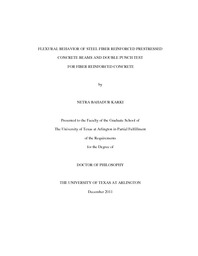
ATTENTION: The works hosted here are being migrated to a new repository that will consolidate resources, improve discoverability, and better show UTA's research impact on the global community. We will update authors as the migration progresses. Please see MavMatrix for more information.
Show simple item record
| dc.contributor.author | Karki, Netra Bahadur | en_US |
| dc.date.accessioned | 2012-07-25T19:06:50Z | |
| dc.date.available | 2012-07-25T19:06:50Z | |
| dc.date.issued | 2012-07-25 | |
| dc.date.submitted | January 2011 | en_US |
| dc.identifier.other | DISS-11553 | en_US |
| dc.identifier.uri | http://hdl.handle.net/10106/11015 | |
| dc.description.abstract | Steel fibers have widely been used in the past to reinforce brittle materials in many nonstructural applications such as pavement, tunneling lining, etc. On the basis of numerous previous studies, ACI 318-11 [2011] has recently accepted steel fiber as a minimum shear reinforcement replacement with minimum 0.75% volume fraction for both reinforced concrete and prestressed concrete members. However, not much previous research has talked about the flexural behavior of fiber reinforced concrete (FRC). As per ACI 318-11 for tension-controlled sections, the net tensile strains in the outermost layer of steel, εt, should be greater than or equal to 0.005 and for the moment redistribution in continuous beam the section should sufficiently ductile (εt [greater or equal to] 0.0075). For this, the sections should have small longitudinal reinforcement ratio which ultimately leads to an inefficient beam section with a large cross-sectional area. In contrast, the use of smaller concrete cross sections can lead to a diminished ductile flexural behavior as well as premature shear failure. In this context, the use of steel fiber reinforced concrete could be a potential solution since fiber can increase both the concrete shear strength and it's usable compressive strains. However limited previous researches on the flexural behavior on SFRC beams are available and most of them are of small scales and concentrated only basically for shear behavior. To the best of our knowledge, the large-scale prestressed fiber reinforced concrete beam specimens have yet to be studied for flexure behavior. In this project, six large scale prestressed concrete beams with or without steel fiber along with some material test were tested. Our experimental investigations indicated that even with inclusion of small percentage volume of fraction of steel fiber (Vf =0.75%) could not only increase the ductility and shear strength of the SFRPC beam but also change the failure pattern by increasing usable strain in concrete and steel. A modification on the limit for c/dt ratio and [phi] factor for design of flexural member given in current ACI could be proposed which could imply the smaller sections with higher longitudinal reinforcement ratio and less shear reinforcement. could be used. Any standard material test results have to ensure that FRC has, at least, been batched properly and it can give indications of probable performance when used in structures. In the current material testing method suggested by ACI, the third point bending test (ASTM C1609) has an inherent problem in that the coefficients of variations for post cracking strength and residual strength are generally very high on the order of 20%. The direct tensile test can be a more appropriate material. However, it is currently not recommended as standard method in the U.S. Because of it's difficultly in gripping arrangement which will lead to cracking of the specimen at the grips. Both the test methods also require close loop servo controlled machine. The round panel test method (ASTM C1550) requires large size specimen and heavy steel supports prevents performing test in small laboratories. Split cylinder test (ASTM C496), do not necessarily reflect the true properties of the material as the specimen is forced to fail in the line of the application of the load and the test method is also not recommended by ACI for SFRC. In order to improve the material assessment procedure, the double Punch Test (DPT) introduced by Chen in 1970 [Chen, 1970] was extensively evaluated to develop a simple, quick and reliable testing method for SFRC. Various tests were carried out in order to evaluate peak and residual strength, stiffness, strain hardening and softening, toughness and other post crack properties. Our test results indicated that the DPT method could be immersed as reliable, easier and economical material test method. It could be used to distinguish the peak strength, residual strength, toughness stiffness and crack resistance, of different SFRC mixtures with less scatter results compared to other material test methods. | en_US |
| dc.description.sponsorship | Chao, Shih-Ho | en_US |
| dc.language.iso | en | en_US |
| dc.publisher | Civil & Environmental Engineering | en_US |
| dc.title | Flexural Behavior Of Steel Fiber Reinforced Prestressed Concrete Beams And Double Punch Test For Fiber Reinforced Concrete | en_US |
| dc.type | Ph.D. | en_US |
| dc.contributor.committeeChair | Chao, Shih-Ho | en_US |
| dc.degree.department | Civil & Environmental Engineering | en_US |
| dc.degree.discipline | Civil & Environmental Engineering | en_US |
| dc.degree.grantor | University of Texas at Arlington | en_US |
| dc.degree.level | doctoral | en_US |
| dc.degree.name | Ph.D. | en_US |
Files in this item
- Name:
- Karki_uta_2502D_11553.pdf
- Size:
- 12.69Mb
- Format:
- PDF
This item appears in the following Collection(s)
Show simple item record


